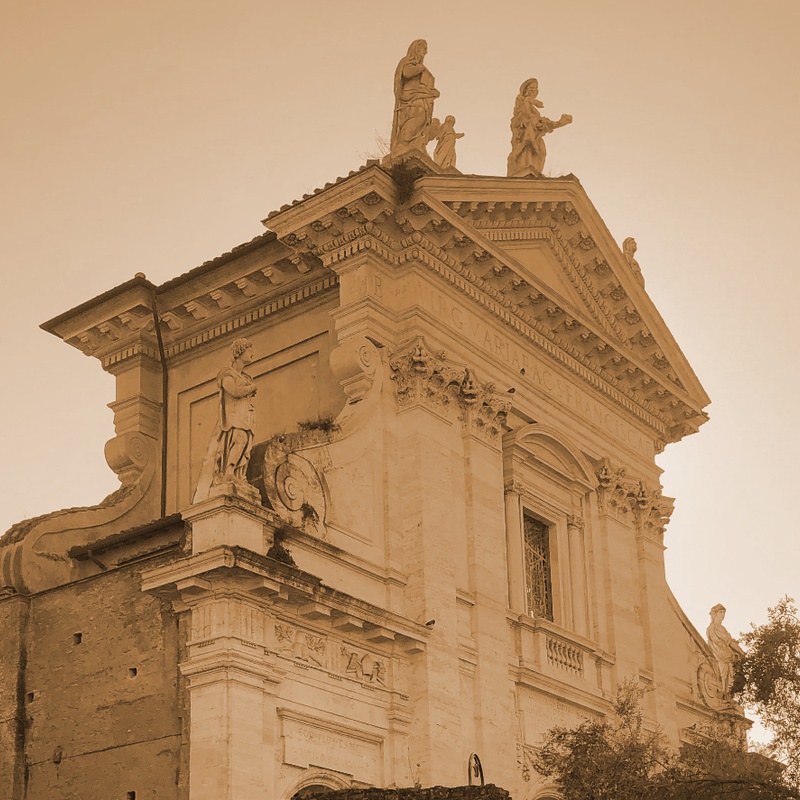Posted by Roberto D'Autilia on 25 Apr 2022
Santa Francesca Romana
8th century - Rome
Religious site / Temple
<p>An oratory putatively was established in the eighth century under Pope Paul I in the portico of the former Temple of Venus and Roma. Tradition holds that at this site Saint Peter prayed at the site to challenge Simon Magus. According to this legend, Simon Magus wanted to prove his pagan powers were greater than those of the apostles, and started levitating in front of Peter. The apostle fell on his knees to prayer, asking God to demonstrate his pre-eminence, and Simon fell, dying. Tradition holds that the basalt stones where the apostle's knees during prayer are embedded in the wall of the south transept.</p> <p>A church at the site was known by the tenth century, was named Santa Maria Nova (or "Nuova", "New St Mary"), to distinguish it from the other church inside the Roman forum devoted to St Mary, Santa Maria Antiqua ("Ancient St Mary"), which had fallen into ruin by then. The relics from the ancient church were moved to this church under Pope Leo.</p> <p>Santa Maria Nuova was enlarged in the second half of the tenth century, and then rebuilt by Pope Honorius III in the thirteenth century, adding the campanile and the apse, as well as being decorated with a mosaic Maestà, a depiction of the Madonna enthroned accompanied by saints. The belltower and apse are now located at the east end of former Roman temple, where the portico and entry stairs stood. Behind (East) of the apse and bell tower are a jumble of structures forming the former monastery with two small courtyards. Flanking the north of these structures and extending further west on both sides towards the Colosseum are the remaining outer columns of the massive ancient Roman temple.</p> <p>Since 1352 the church has been in the care of the Olivetans. In the 16th century, the church was rededicated to Frances of Rome (Francesca Buzzi), who was canonized in 1608 and whose relics are in the crypt. The interior of the church has undergone many refurbishments. The present travertine porch and façade (1615) were designed and built by Carlo Lambardi.</p> <p>The interior, a single nave with side chapels, was rebuilt by Lombardi in the years preceding Francesca Buzzi's canonization, beginning in 1595. In the middle of the nave is the rectangular schola cantorum of the old church, covered in Cosmatesque mosaics. Another prominent feature is the confessional designed by Gian Lorenzo Bernini (1638–49), in polychrome marbles with four columns veneered in jasper. Among the altarpieces are works by Pietro Tedeschi, Padre Pozzi, and Subleyras.</p> <p>The sacristy houses the precious Madonna Glycophilousa ("Our Lady of Tenderness"), an early 5th-century icon brought from Santa Maria Antiqua. The twelfth-century Madonna and Child had been painted over. It was meticulously detached from the panel in 1950.</p> <p>The tomb of Pope Gregory XI, who returned the papacy to Rome from Avignon, reconstructed to a design by Per Paulo Olivieri (signed and dated 1584) is in the south transept.</p> <p>The Deaconry was suppressed on 8 August 1661. S. Maria Nova was reestablished, as the Titulus of a Cardinal Priest, on 17 March 1887 by Pope Leo XIII. The titulus of the church remains Sancta Mariae Novae; the current Cardinal Priest of the Titulus S. Mariae Novae is Angelo Sodano. A Cardinal Priest no longer has any jurisdiction over his titular church or its clergy. He is only the Cardinal Protector.</p> <p>Saint Francesca Romana has been named the patron of car drivers, because of a legend that an angel used to light her way with a lamp when she travelled at night. Automobiles line up on the day of her feast (9 March) as far as the Colosseum, to partake of the blessing.</p> <p>The facade of the Church of Holy Cross College, in Clonliffe in Dublin, Ireland, is a replica of Santa Francesca Romana. It was designed by the Gothic Architect J.J. McCarthy and is the only exception to his list of Gothic works.</p>
